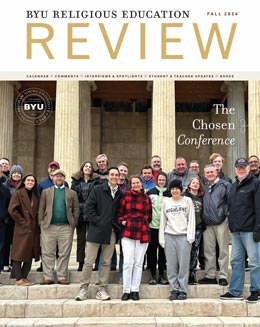Stephen O. Smoot (Stephen_smoot@byu.edu) is a doctoral candidate in Semitic and Egyptian Languages and Literature at the Catholic University of America and an adjunct instructor of ancient scripture at Brigham Young University.
Brian C. Passantino (Brian.Passantino@churchofjesuschrist.org) is a research consultant for the Church History Department of The Church of Jesus Christ of Latter-day Saints. He is also a doctoral student at the University of Utah in history.
Joseph Smith, the Prophet of the Restoration, produced hundreds of recorded prophecies, visions, revelations, and manifestations during his prophetic ministry.[1] Many of these revelations and visions are canonized for members of The Church of Jesus Christ of Latter-day Saints in the Doctrine and Covenants. However, it may come as a surprise to some Latter-day Saints that not all of Joseph Smith’s revelations are found in the Doctrine and Covenants. A significant number of revelations—a few dozen at least—have, for a variety of reasons, gone uncanonized since their first pronouncement. Although perhaps not as well-known as their canonized counterparts, these texts are no less important in helping Latter-day Saints appreciate Joseph Smith as a modern revelator and prophet. Besides this, they are valuable to scholars and historians seeking to understand Joseph Smith as an American religious leader.
Thanks to the monumental work of the Joseph Smith Papers Project (JSPP), the Prophet’s papers—his histories, journals, letters, revelations, translations, and other documents—are now better understood and more accessible than at any other time in the history of the Restoration. However, one major problem facing those wishing to navigate the JSPP is the sheer volume of material to wade through. Besides twenty-seven published volumes, the JSPP also offers an expansive website with supplementary resources.[2] But trying to locate Joseph Smith’s uncanonized revelations in this mass of documents is, understandably, going to be either difficult or bothersome for most average readers. To help make these sources more readily accessible, we felt the time was right to produce a single volume collection of the Prophet’s uncanonized revelations. Building on past scholarship,[3] Joseph Smith’s Uncanonized Revelations, published this year with the Religious Studies Center at Brigham Young University and Deseret Book, aims to remove that barrier to help facilitate access to these fascinating revelations. We also hope to enhance the Saints’ study of this material by distilling the latest scholarship on this subject in an approachable yet rigorous manner. Scholars looking for a reference or guide to this corpus of Joseph Smith documents may also find this volume useful.
In this book, we have assembled forty-two revelations or portions of revelations the Prophet produced that went uncanonized in his lifetime and that remain uncanonized today. We have described the methodology for determining what was included in this project in the introduction of the book. Although we were thorough in our efforts to locate uncanonized revelations from Joseph Smith, we acknowledge the likelihood that there are additional uncanonized revelations that escaped our notice and thus do not appear in this volume. We should also say upfront that there are no uncanonized Joseph Smith revelations that fundamentally overturn any teachings of the Church or revolutionize our understanding of who Joseph Smith was. Instead, they provide fuller context to some of Joseph Smith’s teachings and inform our understanding of some specific incidents in the early history of the Restoration. They contain, for example, more information on the duties of bishops, directions for publishing the scriptures, greater context for the practice of plural marriage, instructions for missionaries and local church leaders, and admonishments to live the gospel with greater purpose. They contain inspired and uplifting principles that are in harmony with the restored gospel as taught in the scriptures and also raise some doctrinal questions that are worth readers’ considered attention.
Besides being interesting in their own right, the presence of uncanonized Joseph Smith revelations raises important questions about the nature of the Latter-day Saint canon. What status do we afford these uncanonized revelations? How authoritative are they? What does it mean to have an open canon of scripture where, conceivably, one day these revelations might be included? And how should they be viewed in personal study or used in Church settings? We address these and other important questions in the book, hoping to give some perspective and context for readers as they explore these fascinating documents.
Notwithstanding their place outside of the canon, these revelations in this volume portray a God who is engaged in our lives and who cares about even the seemingly minute details of our daily existence. We acknowledge the hand of the Lord in preserving these revelations and the countless individuals who have contributed to their preservation. Whether or not any of these revelations someday become canonical is something that the Lord will reveal to his appointed servants if and when the time is right. Whatever the case, these revelations stand as a testament to the ongoing restoration of the Church and gospel of Jesus Christ.
Notes
[1] An excellent collection of these sources can be found in John W. Welch, ed., Opening the Heavens: Accounts of Divine Manifestations, 1820–1844, 2nd ed. (Provo, UT: BYU Studies, 2017).
[2] The official website of the JSPP is www.josephsmithpapers.org.
[3] Previous publications that have collected the Prophet’s uncanonized or unpublished revelations include Fred C. Collier, Unpublished Revelations of the Prophets and Presidents of The Church of Jesus Christ of Latter-day Saints, vol. 1 (Salt Lake City: Collier’s, 1979); H. Michael Marquardt, The Joseph Smith Revelations: Text & Commentary (Salt Lake City: Signature Books, 1999). While earlier books such as these two provided foundational work, they are now fairly outdated and out of print, making them expensive and not easily obtainable for average readers.
